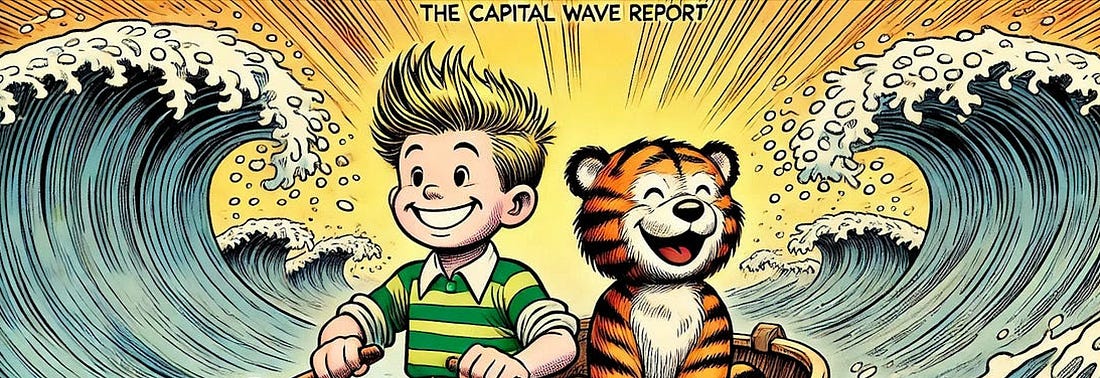You are a free subscriber to Me and the Money Printer. To upgrade to paid and receive the daily Capital Wave Report - which features our Red-Green market signals, subscribe here. How Surfing Taught Me to Read MarketsThere's no AI, no patents, no algorithms, and no models. Just basic equations that tell us when it's time to dive head first into the water or get the hell off the beach.Dear Fellow Traveler: When I was in high school, I wanted to go to college in Malibu. My dad laughed when I told him. "Have you ever been there?" he asked. I hadn't. "You'll never get anything done," he said. I drove up Pacific Coast Highway in a white Mustang six years later. I stood on the hill at Pepperdine. Below me, perfect waves rolled into Surfrider Beach. My dad was right. I would've spent four years in that ocean. Twenty years later, I'm still a terrible surfer. But I learned something powerful: The ocean teaches you more about markets than any chart ever will. The market isn't a machine. It's an ocean. You don't control it. But if you understand how it works, you can ride its waves and make a lot of money. Let me show you the three forces that move every market. Liquidity: The Ocean's DepthRule One: Check if the tide is coming in or going out. Liquidity is the water itself. It's all the money sloshing around the system — from central banks, money markets, corporate credit, lending windows. Everything. Think of it like the tide. High tide means deep water. Waves can form. You can surf. Low tide means shallow water. Exposed rocks. Danger. In markets, liquidity is the total money available to buy things. When the Federal Reserve prints money, when hedge funds and other financial institutions create credit, that's high tide. Liquidity drives risk assets. When the Fed "does QE" or lowers rates (impacting the quality of collateral), they're adding water to the ocean. More money flows into stocks, bonds, and real estate. Prices rise. Even bad companies go up because there's so much money that it has to go somewhere. When the Fed tightens or there’s a refinancing crisis? That's low tide. They raise rates. They stop printing. Money drains out. Suddenly, you're trying to surf over rocks. Remember: Before you look at any stock or chart, ask yourself — is the tide coming in or going out? No water, no waves. No liquidity, no rally. That’s not that difficult to measure. Momentum: How Waves FormRule Two: Don't predict the wave. Recognize it. You've got water. But is anything happening? Momentum is the energy moving through the market. It's the difference between a flat ocean and building swells. You can measure it with technical tools, but really, it's about crowd psychology. Millions of traders are starting to move in the same direction. We built an equation that measures market temperature. Like checking the surf report before you drive to the beach. This equation has warned us before every major downturn since February 2020. Here's what just happened:
Good surfers don't guess where waves will come from. They watch the ocean. They see swells building. They position themselves. In markets, positive momentum looks like rising prices on growing volume. Sectors rotating. Money is flowing from defense to offense. Negative momentum? Choppy action. Failed rallies. Distribution. Remember: You don't predict momentum. You recognize it. Then you move with it. Insider Buying: The Local KnowledgeRule Three: Follow the locals. Every surf spot has locals. They know things tourists don't. Where the current pulls. When the break gets dangerous. Which days are magic… Corporate insiders are the market's locals. The CEOs, CFOs, and board members. They live inside their companies. They see the numbers before earnings. They know what's coming. Here's the critical thing: Insiders sell stock for dozens of reasons—kids' tuition, divorce, a new yacht, diversification—but they only buy for one reason—they believe the stock is going higher. On April 8-9 this year, we saw massive insider buying across the market and record buying in TQQQ, right before President Trump canceled Liberation Day. The locals were paddling out hard. That blue line below is the five-day moving average of the Insider Buying to Selling ratio. When it’s up at the top of the chart, insiders are buying. When insiders buy with their own money, they're not guessing. They're betting on information we don't have yet. And they had information on what the President was doing. Previous policy changes have included Fed pivots, Treasury Department debt changes, or big moves by foreign central banks. Remember: When multiple insiders start buying, pay attention. The locals know their beach. How These Forces Work TogetherMost traders fail because they only watch one force. Technical traders worship momentum, value investors ignore liquidity, and Fed watchers miss insider signals. That's like trying to surf by only checking the wind. Real surfing requires reading everything: tide, swell, wind, current, and break. Real trading requires the same complete view. Look at April 2025:
All three forces aligned. That's when you paddle. Why This Framework Matters NowWe're living through something new. Central banks discovered they can create infinite liquidity. Push a button, create trillions. This changed the game forever. The old models assumed markets were like swimming pools. Contained. Measurable. Predictable. But we're surfing an ocean now. Fed policy creates tsunami-sized waves. Momentum can turn violent. And the insiders? They see the storms coming. My approach isn't about prediction. It's about reading conditions and responding intelligently. Because here's what my dad understood that day in Malibu: Beautiful views can be dangerous distractions. The ocean doesn't care about your plans or your theories. But if you respect it, if you learn to read it, if you move with it instead of against it? You might catch the wave of your life. Finally…You’ve seen the philosophy behind Me and the Money Printer (and the paid Capital Wave Report) that tracks momentum, liquidity, and insider buying. It also provides a daily update on conditions, helping you to manage risk and know when it’s time to paddle. We track liquidity to know if there's water. We measure momentum to spot forming waves. We follow insiders because locals know best. It's not fortune telling. It's not guru magic. It’s not some junk AI that won’t work. It’s not patents or patterns or whatever bullshit it is that people are claiming these days. This is about watching how money moves through modern markets. It’s mathematics at its finest. Because in the end, we're all just surfers trying to read the next set. Stay positive, Garrett Baldwin About Me and the Money Printer Me and the Money Printer is a daily publication covering the financial markets through three critical equations. We track liquidity (money in the financial system), momentum (where money is moving in the system), and insider buying (where Smart Money at companies is moving their money). Combining these elements with a deep understanding of central banking and how the global system works has allowed us to navigate financial cycles and boost our probability of success as investors and traders. This insight is based on roughly 17 years of intensive academic work at four universities, extensive collaboration with market experts, and the joy of trial and error in research. You can take a free look at our worldview and thesis right here. Disclaimer Nothing in this email should be considered personalized financial advice. While we may answer your general customer questions, we are not licensed under securities laws to guide your investment situation. Do not consider any communication between you and Florida Republic employees as financial advice. The communication in this letter is for information and educational purposes unless otherwise strictly worded as a recommendation. Model portfolios are tracked to showcase a variety of academic, fundamental, and technical tools, and insight is provided to help readers gain knowledge and experience. Readers should not trade if they cannot handle a loss and should not trade more than they can afford to lose. There are large amounts of risk in the equity markets. Consider consulting with a professional before making decisions with your money. |
Subscribe to:
Post Comments (Atom)




0 Response to "How Surfing Taught Me to Read Markets"
Post a Comment